Table of Contents
- Use AI for campaign ideation — Tools like Ideamap.ai can help brainstorm creative, election-relevant angles tied to your brand.
- Relevance is critical — Google (and AI) prioritize content that aligns topically with your brand’s authority and expertise.
- Real-time monitoring wins — Set up alerts and monitor X/#journorequest to catch timely PR opportunities before AI tools surface them.
- Target outside the election bubble — Niche, non-political publications are less crowded and still looking for strong stories.
- Shift strategies during noise — Evergreen and high-link-intent content (e.g., statistics, tools) perform better when news cycles are saturated.
At one point during the summer Olympics, I saw a compelling LinkedIn post from a fellow digital PR, Victoria Schmid.
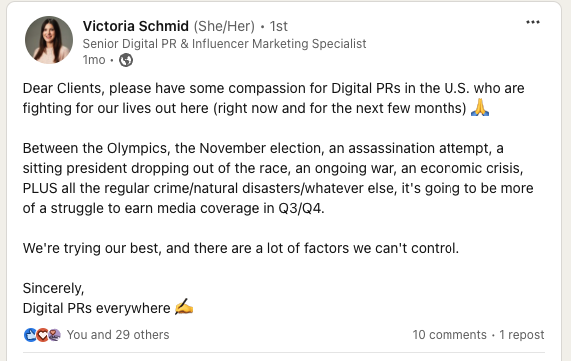
I realized that so many people face a similar challenge consistently at some point in the world, likely every year.
When big news like an election occurs, it creates a new vacuum, sucking up everything in its path.
Digital PRs suddenly see open rates, click-through rates, and responses drop precipitously and scramble to meet KPIs and link goals.
But it doesn’t have to be that way.
In this post, I’ll share some tactics for success from our experts that you can use for elections and any major planned event that is taking over the news.
Tactic 1: Connect Your Brand to the Election
“What I would recommend is where possible, to try to have some quiet time from large campaign launches and where it suits the brands you’re working with lean into the election.
For example we work with a large gambling brand in the US where we have already seen large success looking at the odds of which presidential candidate will win.”
This came from Will Hobson, VP of PR at Rise at Seven, and brings up a great point: some brands can lean into the election with campaigns that add to the conversation or help voters out.
This can be seen as a kind of newsjacking. Can you take a news point or trend and leverage it for coverage?
The hard part here, however, is connecting your brand with the election in a meaningful way so that you can build relevant links.
Here’s how to do it.
1. Brainstorm Connections to Your Brand
AI is my favorite brainstorming buddy.
Using the AI-powered brainstorming tool Ideamap.ai (which I tested when reviewing PR AI tools), you can easily connect the dots between different industries and the election.
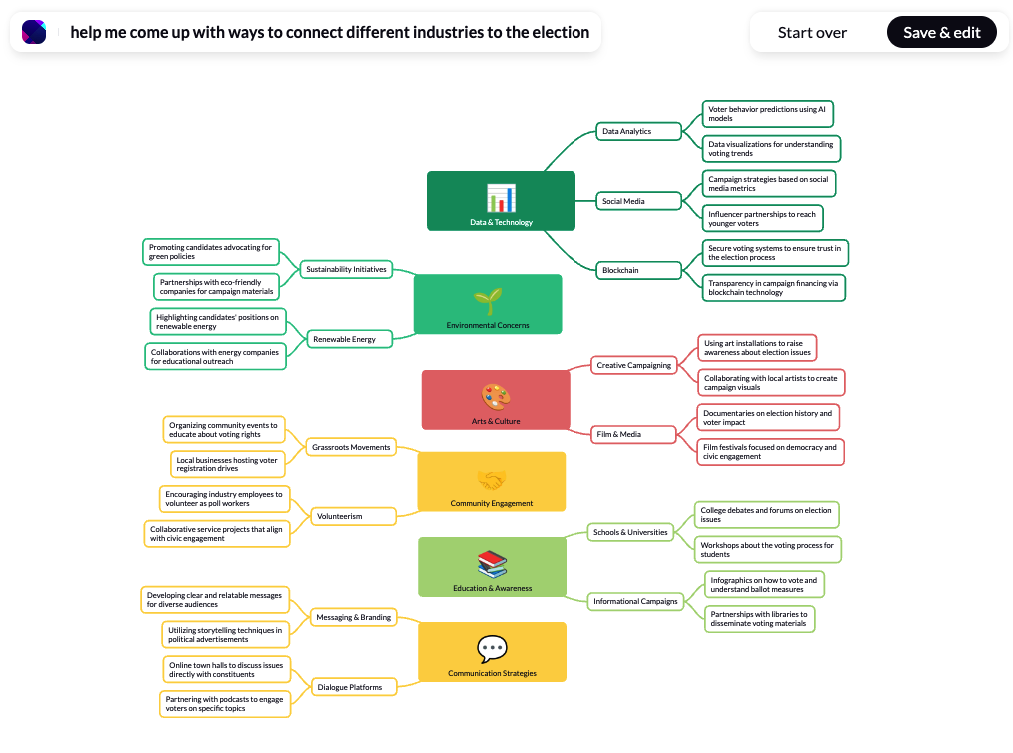
The next step is ensuring it’s a fit.
2. Confirm Relevance
Once you have an idea, you must ensure that you or your brand can speak to the topic as an authority.
An excellent suggestion from James Brockbank during our podcast conversation about content relevance was to ask if you or your brand would be able to speak at an expert level if a newscaster were to interview you or your brand about this topic (something that can often occur in digital PR).
For example, if you were a travel company in Florida, you couldn’t create a post about the election’s impact on the economy.
But, you would be relevant enough to speak about the election’s impact on travel—especially travel to Florida.
Maybe prices are going down on election day? Have prices varied in the past elections?
The added benefit of creating content around relevant topics is that the links you receive will be more appropriate to your brand.
As we saw from the Google leak, relevance seems to be a consideration for Google.
3. Connecting the Dots
Once you’re confident you’ve found a relevant topic, it’s time to create some content.
To help, I discovered some examples of brands that succeeded during the 2020 election.
Example:
VistaPrint, on the surface, has nothing to do with the election. They print business cards.
However, they can speak confidently about small business owners because they are their core customers. To connect to the election, they surveyed 500 small business owners on its potential impact with their data study.
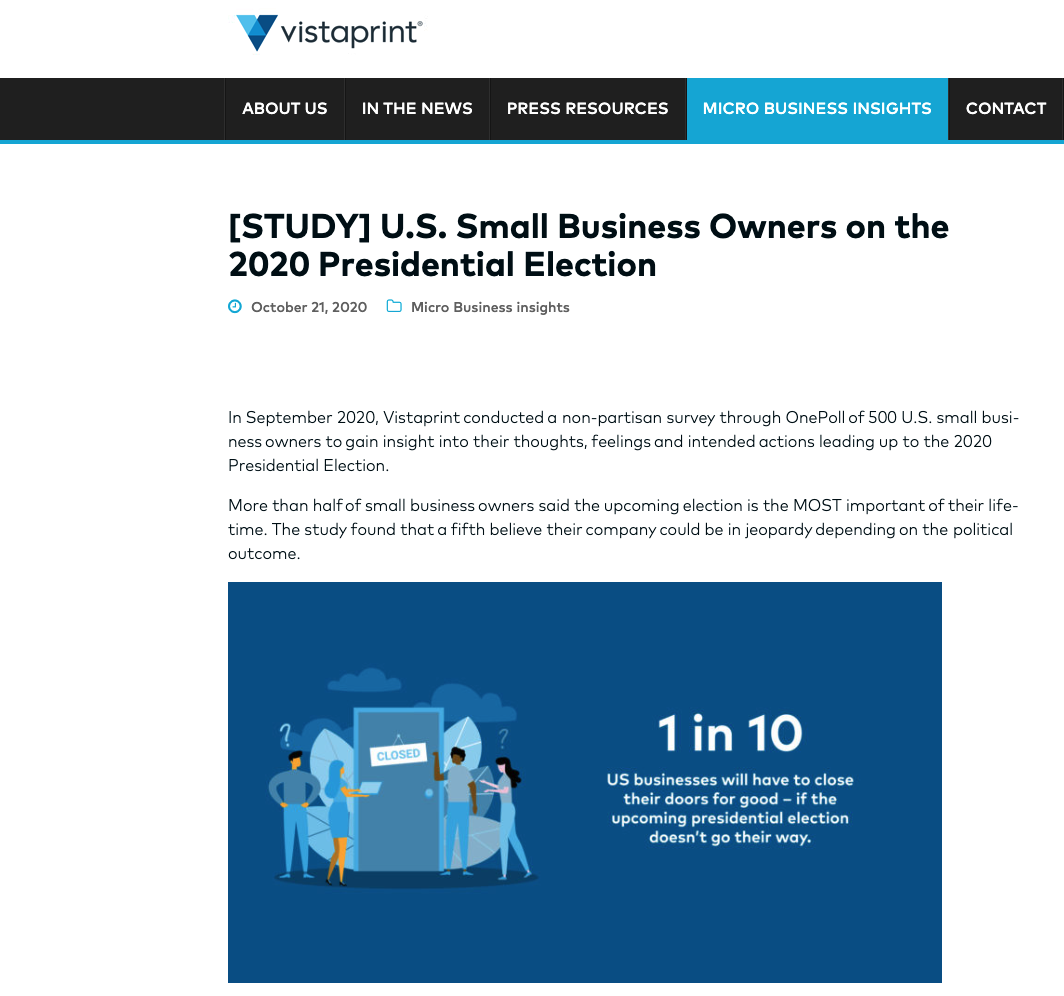
Vistaprint’s core customer is most likely small businesses, so their content aligns perfectly.
Here’s another example:
A very niche site, Trüpp, an HR outsourcing services company, created a guide on how the election might impact employment laws.
The connection here is obviously employment law, a subtopic HR covers.
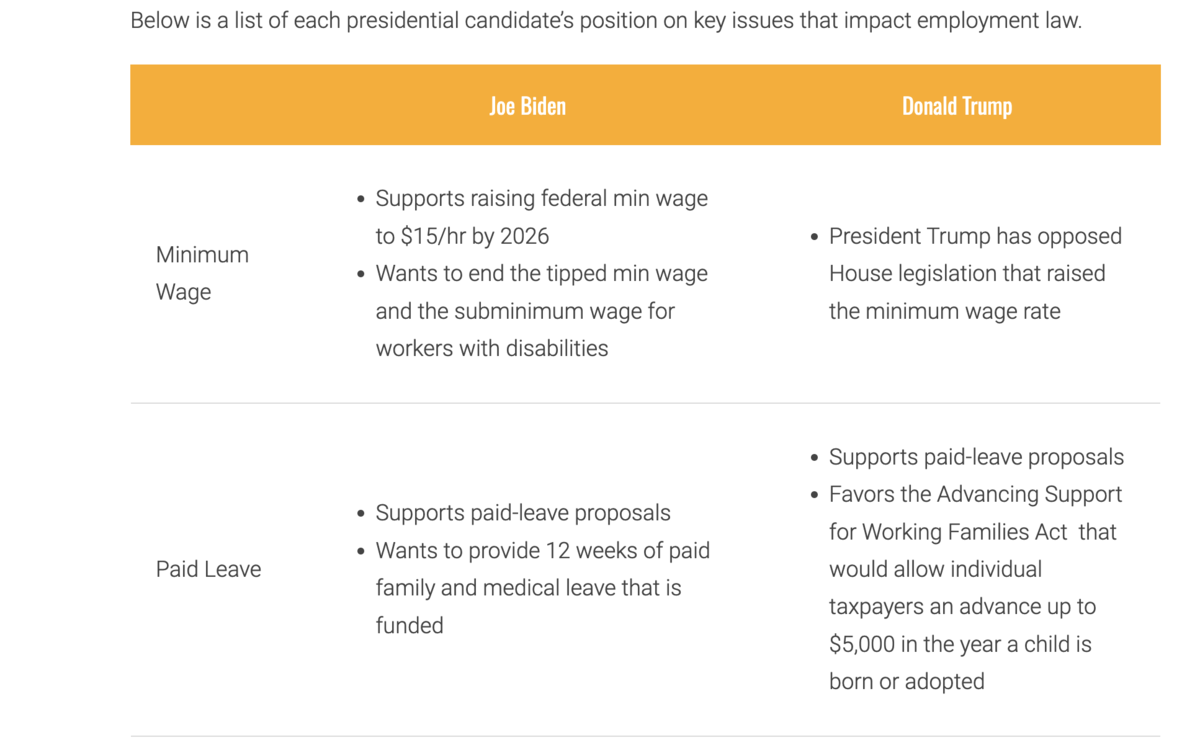
Trüpp’s explained what/how the candidates impact particular laws.
Here’s another example:
Obviously, the threat of cyberattacks is always looming, and with technological advancements each year, this topic will still be big in 2024.
In late 2019, website security software SiteLock created “Presidential Candidate Report Cards” that measured their cybersecurity awareness.
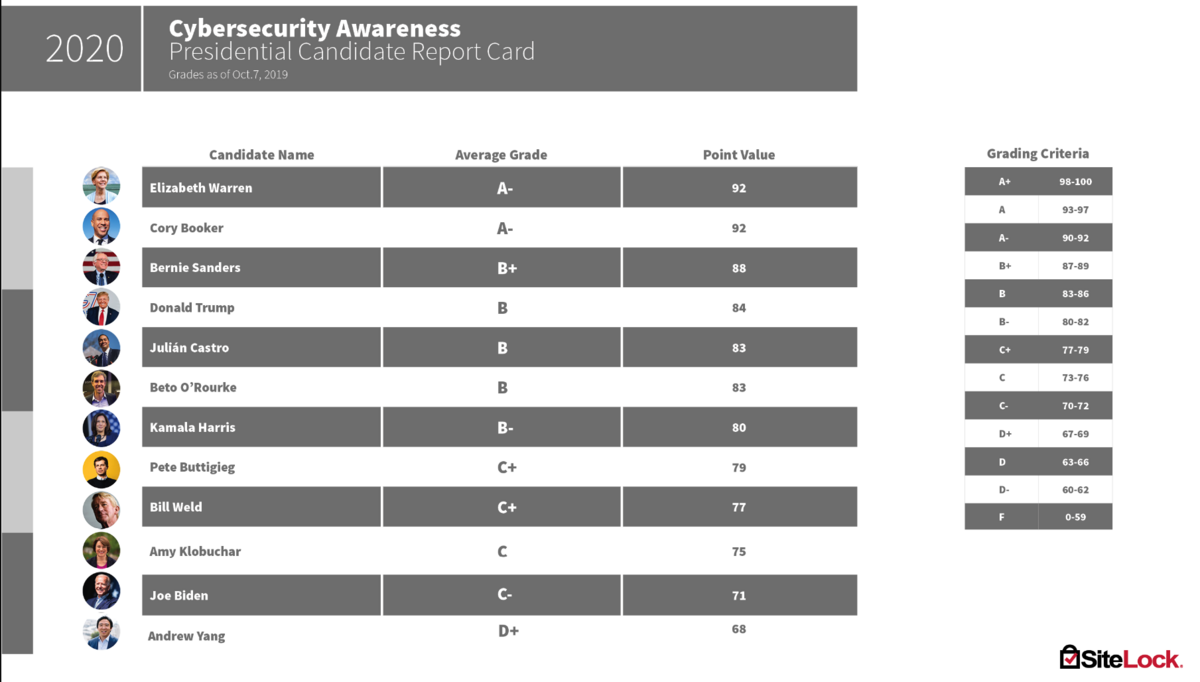
SiteLock could inject itself into the election conversation by framing it around cybersecurity concerns.
(Though not the same format, fast forward to 2024, and cybersecurity is still a concern. This year, the security operations platform Arctic Wolf ran a survey on election-targeted cybersecurity incidents.)
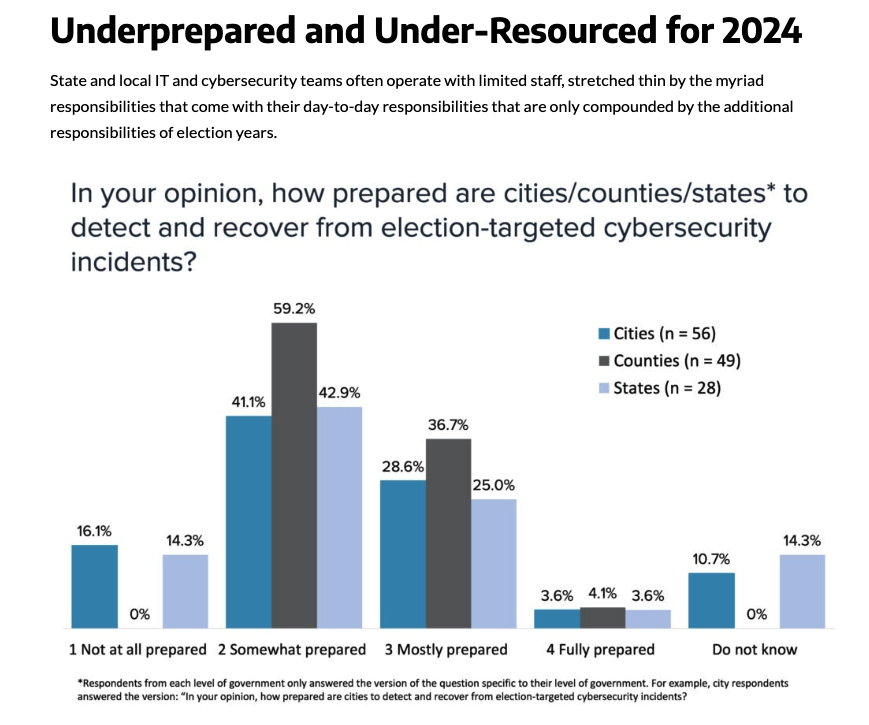
Here’s another example:
The idea of educating the public with Helpful Content (something Google loves) is also something you can see from TikTok in 2020, with their in-app guide to the 2020 elections.
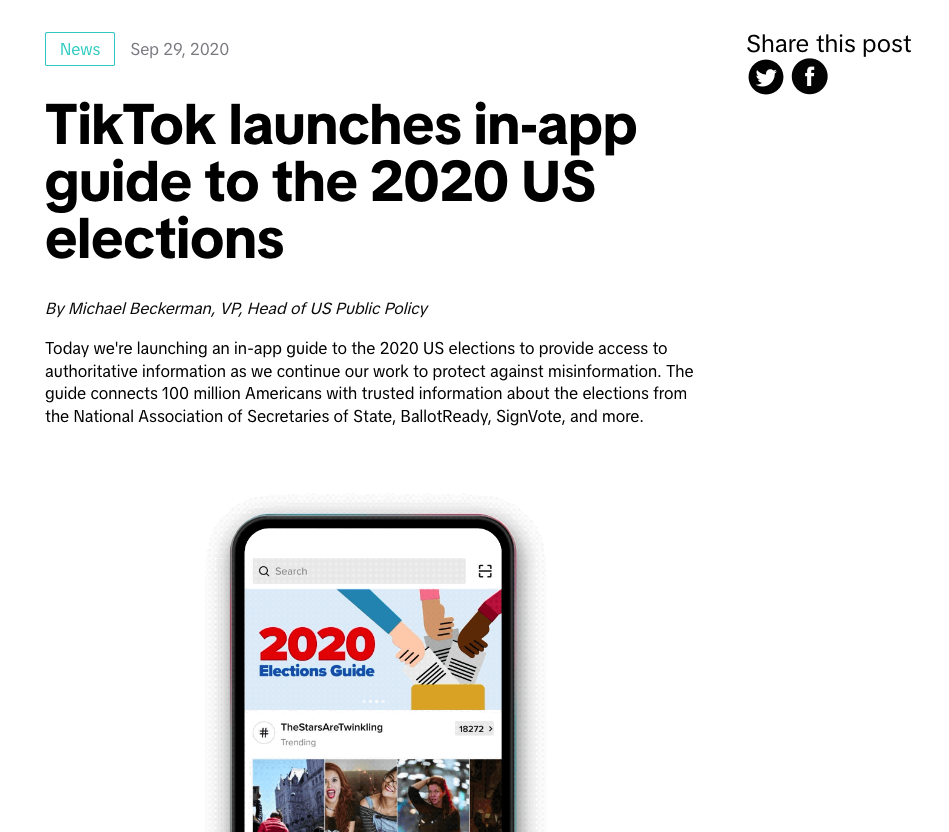
The idea here comes back to the customer and audience. TikTok’s audience is the general public, so their content is tailored to them.
These are all examples of content that has leaned into the election. Let’s examine how you can lean into the election with commentary next.
Tactic 2: Provide Commentary on Election Related Topics
“Identify the trending stories or key election issues where your client can offer valuable insights, and strategically position them as the expert on the political matters at hand.”
This tip comes from Bri Godwin, Digital PR Manager at Journey Further. Journalists are always seeking expert commentary to bolster their stories.
For instance, here’s a request from a journalist at The Hill on a recent news item regarding Teamsters announcing they wouldn’t endorse a presidential candidate in the 2024 election.
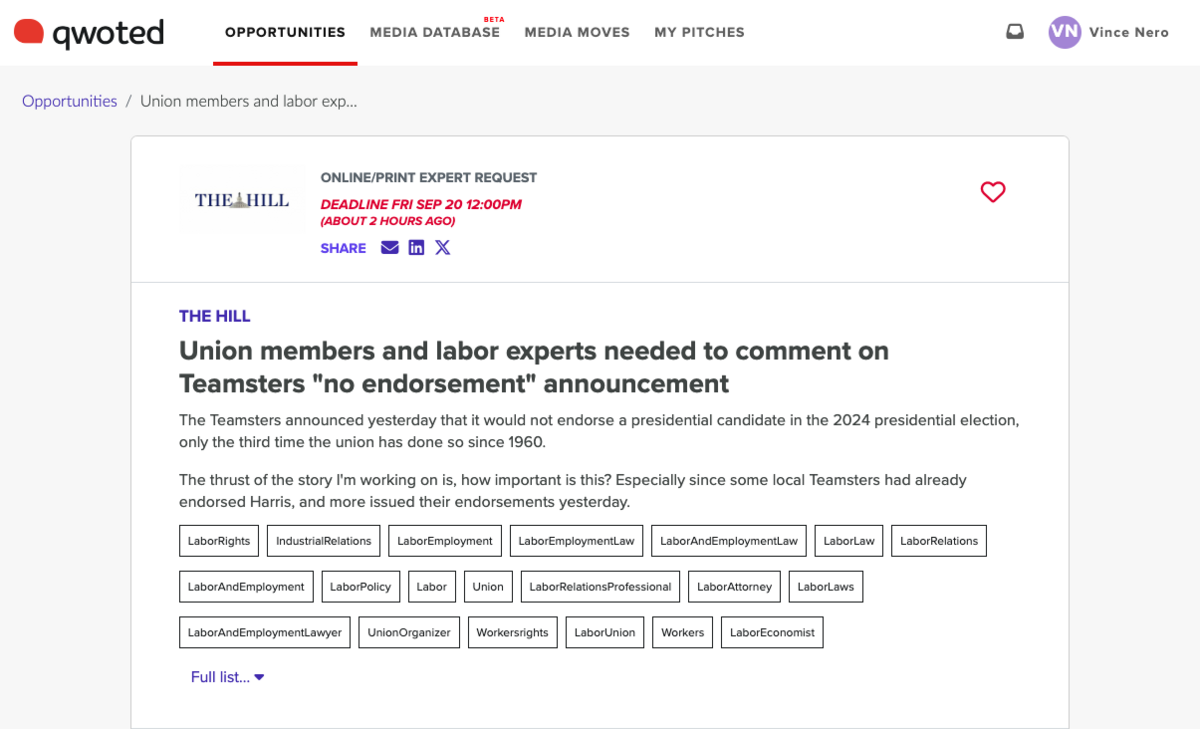
If you can pitch yourself, a thought leader at your company, or your client as an expert, you can get quick links in top news stories of the day.
But, during a busy news cycle, you must know what’s happening to seize opportunities like these.
Bri says, “Given the rapid news cycle leading up to elections, it’s essential to stay on top of daily developments. Check the news regularly and be prepared to provide commentary quickly to increase your chances of attaining key media placements.”
I’ve written a guide to newsjacking, but below, I’ll outline some simple tips for getting your commentary flow up and running.
Here’s how to do it.
1. Set up News Alerts
First, go to Talkwalker. They provide a free alert alternative to Google Alerts. I like Talkwalker a little better because it’s a little less noisy. However, if you are in the UK, I recommend Google Alerts because it allows you to select a country, whereas Talkwalker doesn’t.
In Talkwalker, choose “create an alert,” and you’ll find prompts to enter your search query, location, and frequency of alerts.
You want to make sure you select “news” for the result type, “as it happens” for how often, and “all results” for how many.
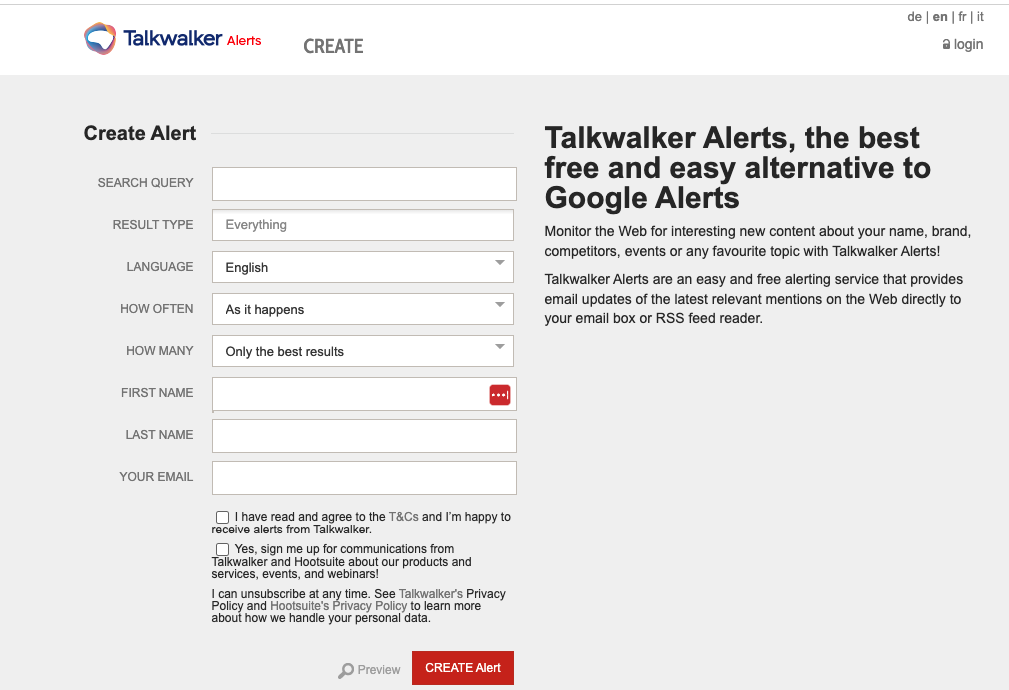
For the search query, you want to enter whatever search will get you closest to your industry.
For example, if your client provides healthcare in Michigan, set up an alert for Michigan healthcare.
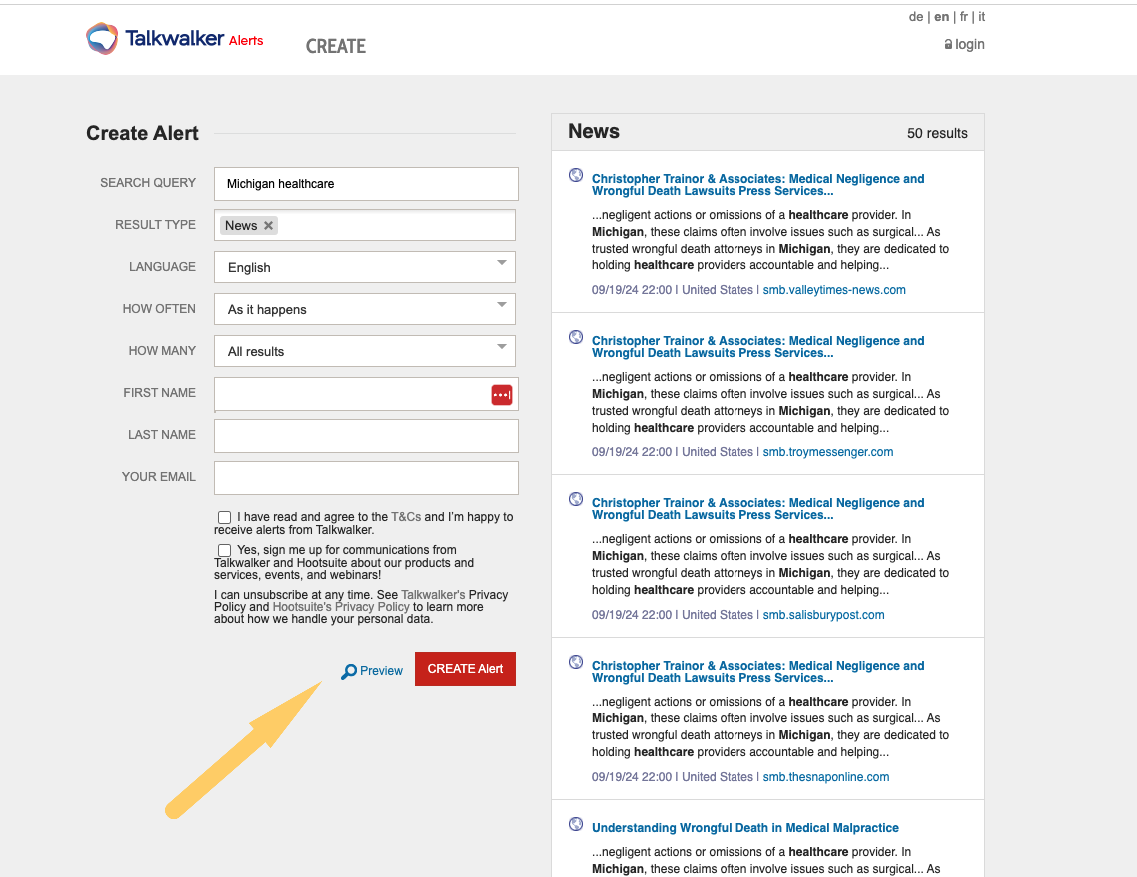
You may have to tweak it once it’s going a bit to filter out more noise, but this should get you the breaking news you need.
If you’re unsure, click the Preview button, which will show you the top results.

Once the alerts start coming in, jump to step 4.
However, you can also use a platform to get you in front of journalists actively seeking pitches, which I’ll explain next.
2. Sign up for Qwoted and other platforms
To get in front of journalists, use a platform like Qwoted, Featured, Connectively (formerly known as HARO, but the name changed after Cision bought them), or Source of Sources (formerly HERO and created by the founder of HARO.)
These platforms can help connect digital PRs to journalists (and vice versa).
With Qwoted, for instance, you can join as a business, PR professional, or journalist.
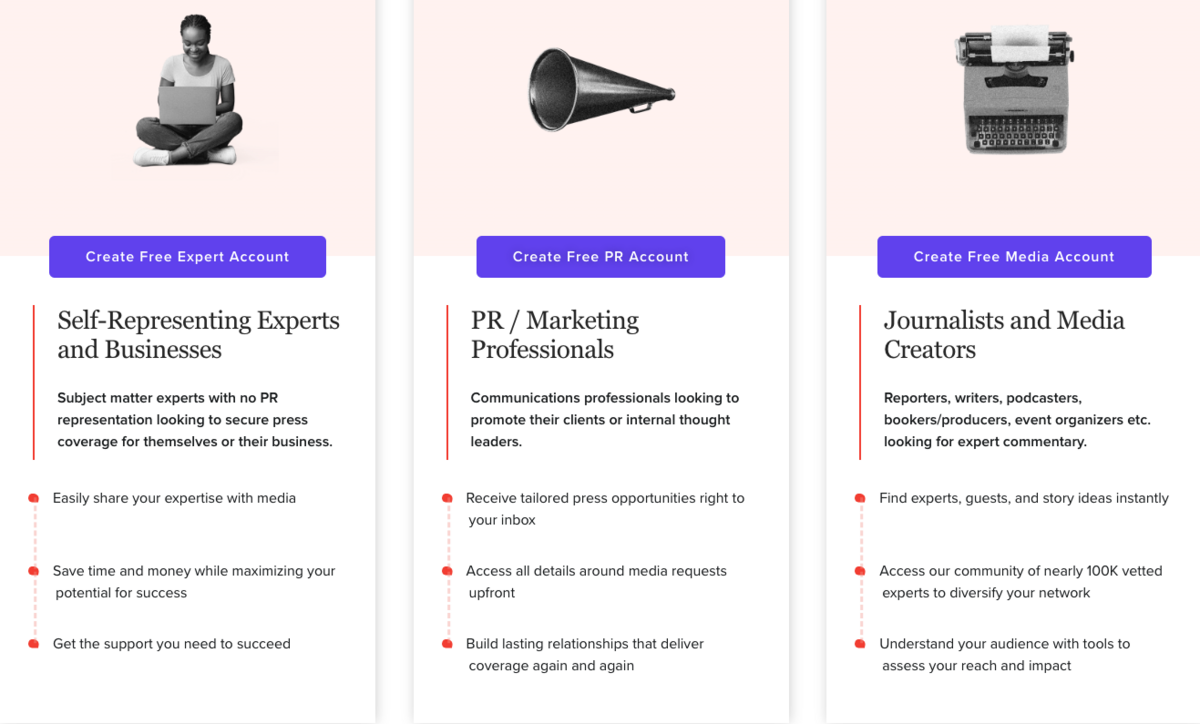
If you are a brand or PR/marketing professional at an agency, I recommend signing up as a self-representing expert.
Once you get set up, the Opportunities tab is full of journalists and publications looking for pitches.

I recommend using the Advanced Search to find opportunities most relevant to you.
For instance, you can target by hashtag (aka topic) or even publication if you know which you’d want to get featured in.
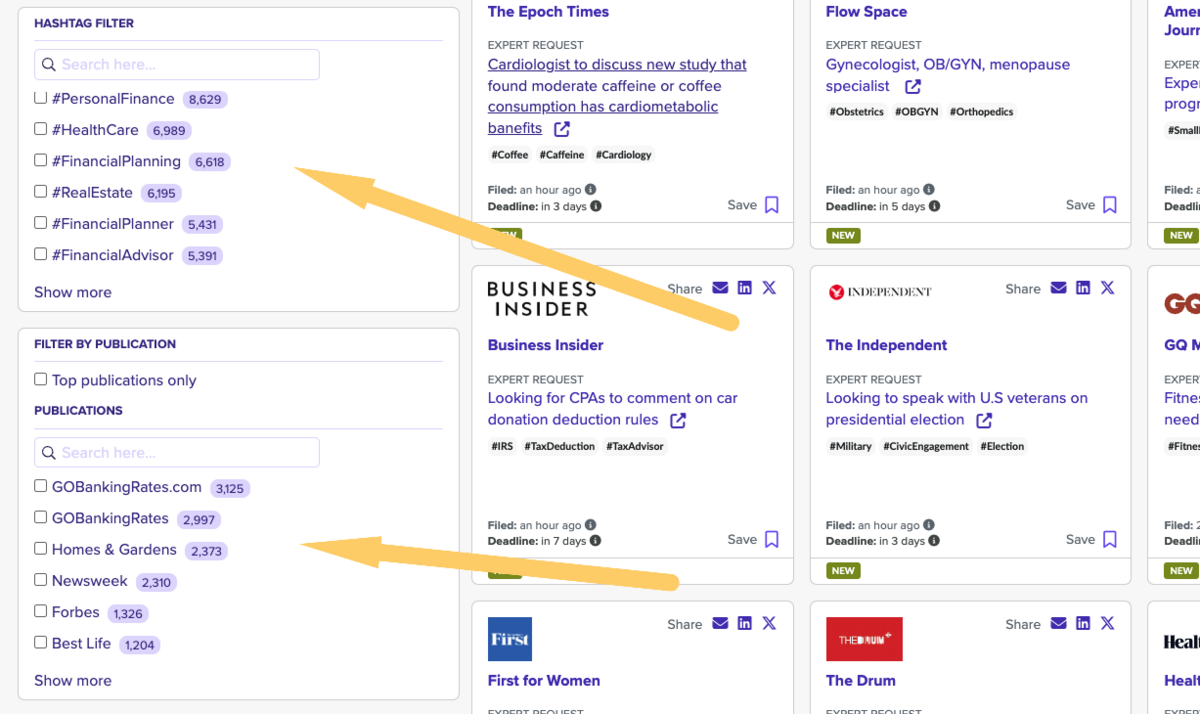
Most importantly, you can also set up alerts to send you emails tailored to your preferences, previous pitches, and search history.
They’ll come in looking like this:

Responding to alerts immediately is the best way to get your pitch in front of the journalist immediately.
With Qwoted, you will need a paid account to respond immediately; otherwise, the platform locks the pitch for an hour.
There is a way around this, which I’ll discuss next.
3. Check X
One of our podcast guests, Amelia Selby of SEO Travel, told me that X is one of the best places to find quote requests before they reach these platforms.
If you go to X, type in #journorequest or #prrequest in the search bar and select “latest.”
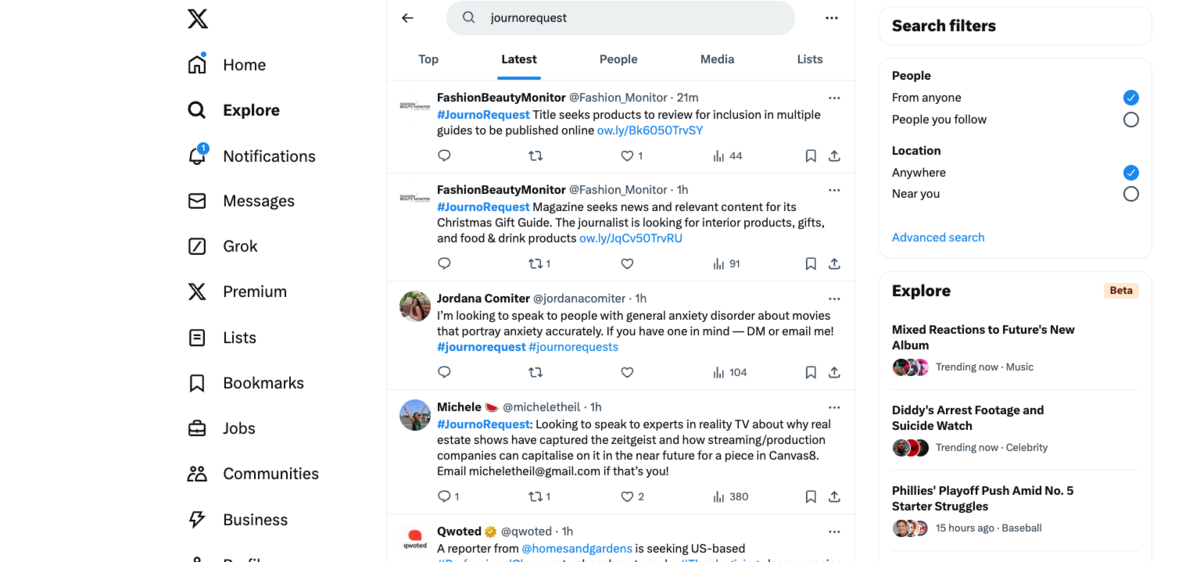
You’ll find journalists, writers, and other PRs looking for requests.
Note that #journorequests and #prrequests are mainly for UK-based digital PRs and sites. US journalists rarely use the #journorequest platform, but you might still see journalists looking for experts.
For instance, here is a request from a journalist at Fortune magazine.
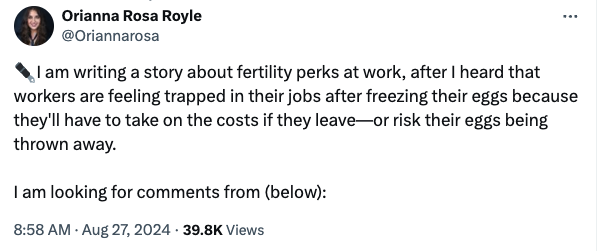
Your best bet is to search for journalists on X using a term like “looking for experts.”
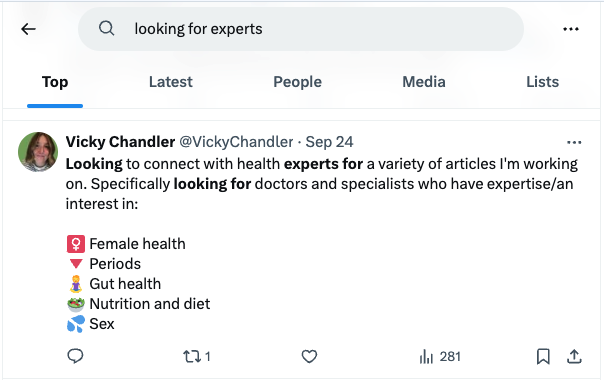
Once you find someone looking, head to the last step.
4. Add Value with Your Commentary
The trick to getting your commentary picked up is to add to the story. You don’t want to just state the obvious.
In our newsjacking post, we cover this extensively, but here are some prompts that can help you add value with a comment:
- Who is this news impacting? How do they relate to my brand?
- What data is missing from the current coverage? What could I add?
- Are there any misconceptions or gaps in the story?
- What problems arise from the story that no one is talking about?
- What unique insights or predictions can I offer?
- How could this development impact the future of my industry?
- What are the potential benefits or opportunities I can highlight from this story?
For example, if the news story is about energy conservation in the upcoming election, can you or your client fill in any holes in the coverage? Provide data? Predict the course of events?
In our podcast with Amelia Selby, she offered these tips:
“If a journalist is asking for some insight into good travel deals, don’t say “book early,” because everyone’s going to know the obvious stuff.
Share something different—some insider secrets or maybe even just give an opposing view.
That’s definitely how we’ve been able to cut through the noise. Obviously, journalists will just get the same tips, just written slightly differently.”
This approach will work on election-related topics, albeit may be crowded, but just as well (and probably even better) on non-election related topics.
However, there’s lots more you can be doing during the election with digital PR. You just have to avoid the sites talking about the election.
Tactic 3: Target Smaller, Niche Publications Not Covering Elections
“You can’t forget about the niche publications who might not be talking about the election at all.”
This was digital PR expert Jodie Booras of Kaiona Communications.
Although the big wins are great, many small publications don’t get much love.
While this is true for small or local new publications most of the year, this is especially true during a big election cycle.
“There is a good chance a lot of PR pros shift their focus to election-based topics then, so this could be a great chance to get in front of them in a much smaller sea of competition!
Also depending on the brand you are pitching, they may not want to take any sort of stance on politics at all.
If this is the case, then you might want to only be pitching those niche publications during this time who still need to put out stories about their industry.”
This tip really works best with digital PR using content, such as a data study or blog post.
Here’s how to do it.
1. Find Sites With Lower Authority
One good indicator of a less popular site is its authority (Domain Authority or Domain Rating).
Organic traffic is a more obvious indicator, though they often align together (Moz’s DA takes traffic into account, where Ahref’s DR focuses solely on number of backlinks.)
This isn’t an exact science, but a large site like the New York Times or BBC will typically have higher authority than local news.
Use a tool like Ahrefs Site Explorer or Moz’s free Domain Authority Checker.
For example, if I’m trying to pitch something related to New York City, I can look at New York news sites, compare their authority, and target lower DR sites.
The image below shows that the NYTimes has a DR of 94, while a smaller local publication, Pix11, has a DR of 80.
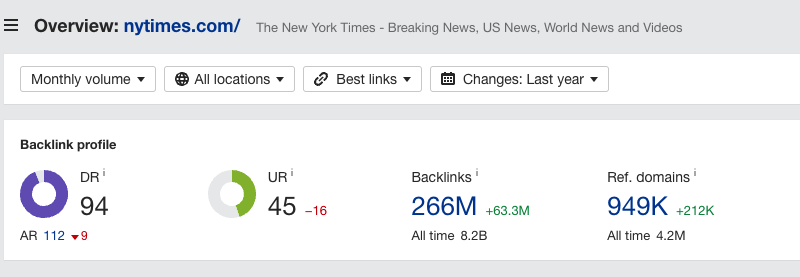
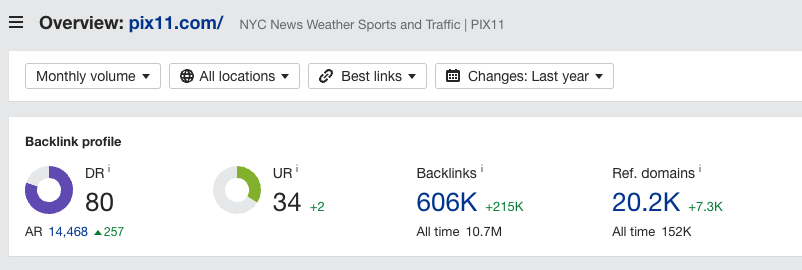
Local radio station websites typically have lower DR but can still provide coverage for a digital PR campaign.
A simple Google search for the “city or town + radio” will get you a good list.
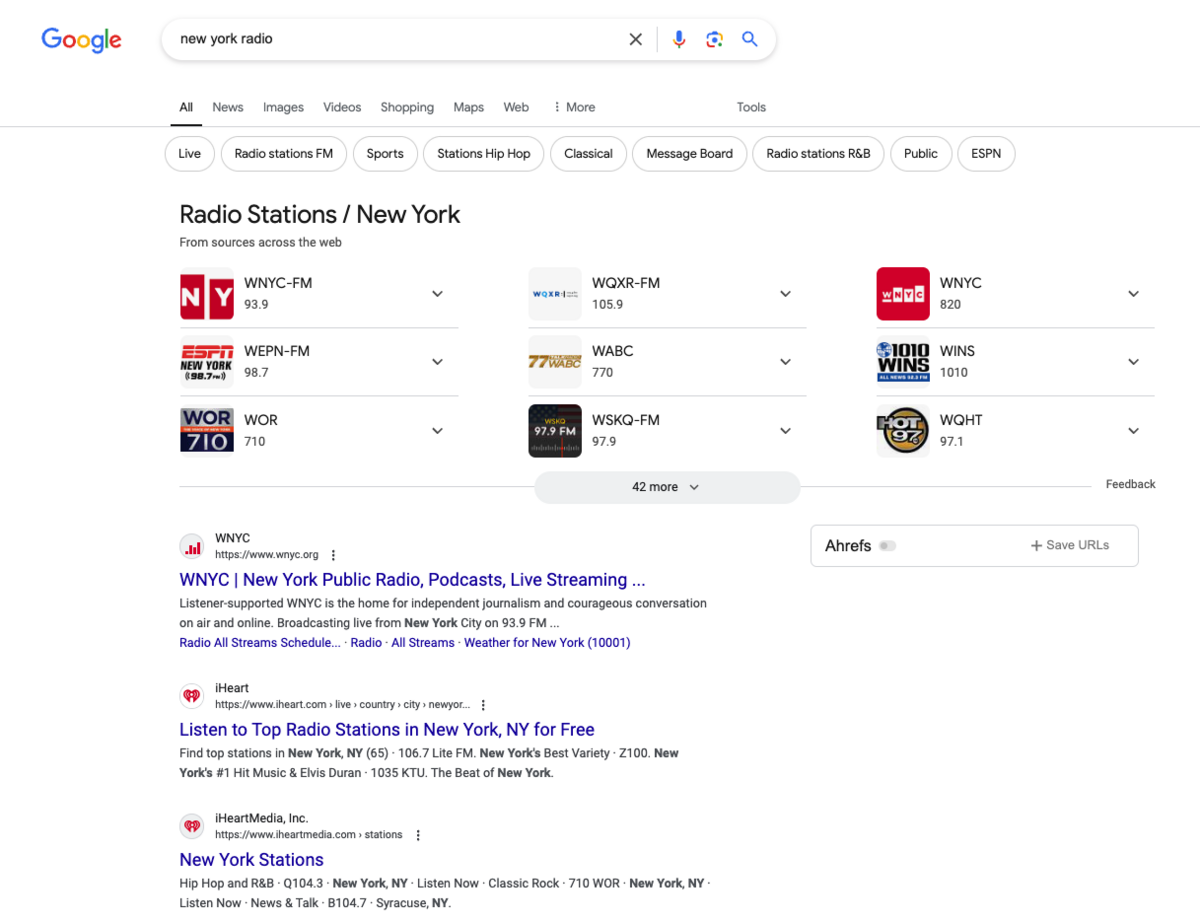
Not all radio stations have websites, but those with them typically have lower authority.
However, they are still valuable from a link perspective, like WABC Radio in New York.
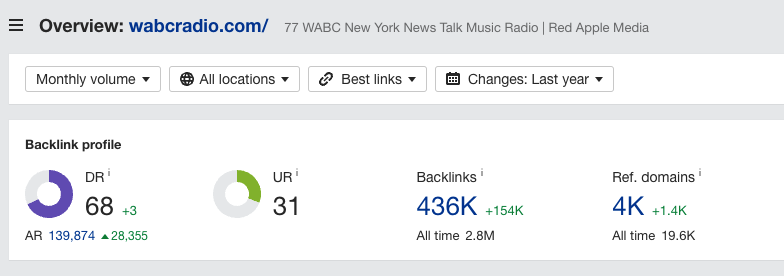
Checking Authority on BuzzStream for Free
You can see a site’s Domain Authority from Moz on BuzzStream even if you don’t have an account with Moz.
Simply start a new project and ensure that Moz Metrics is selected.
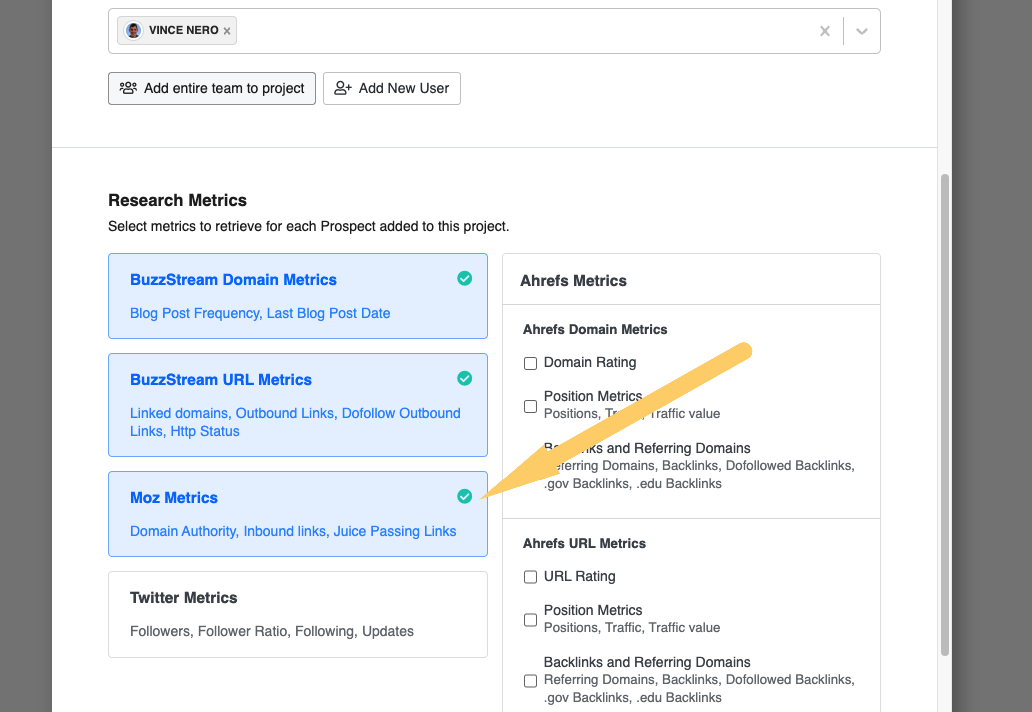
Then, whenever you import websites or search via Google Search, the DA will be listed beside the site.
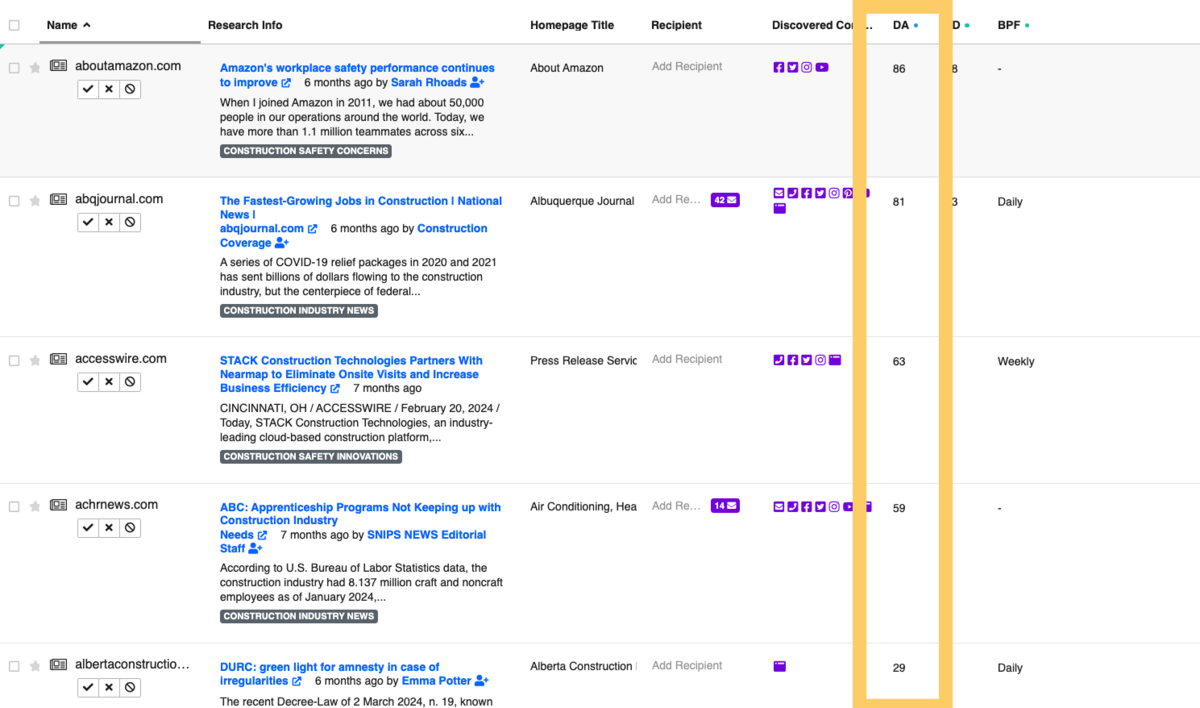
Then, using the filter tools, you can filter or sort by DA. I recommend something between 65-85.
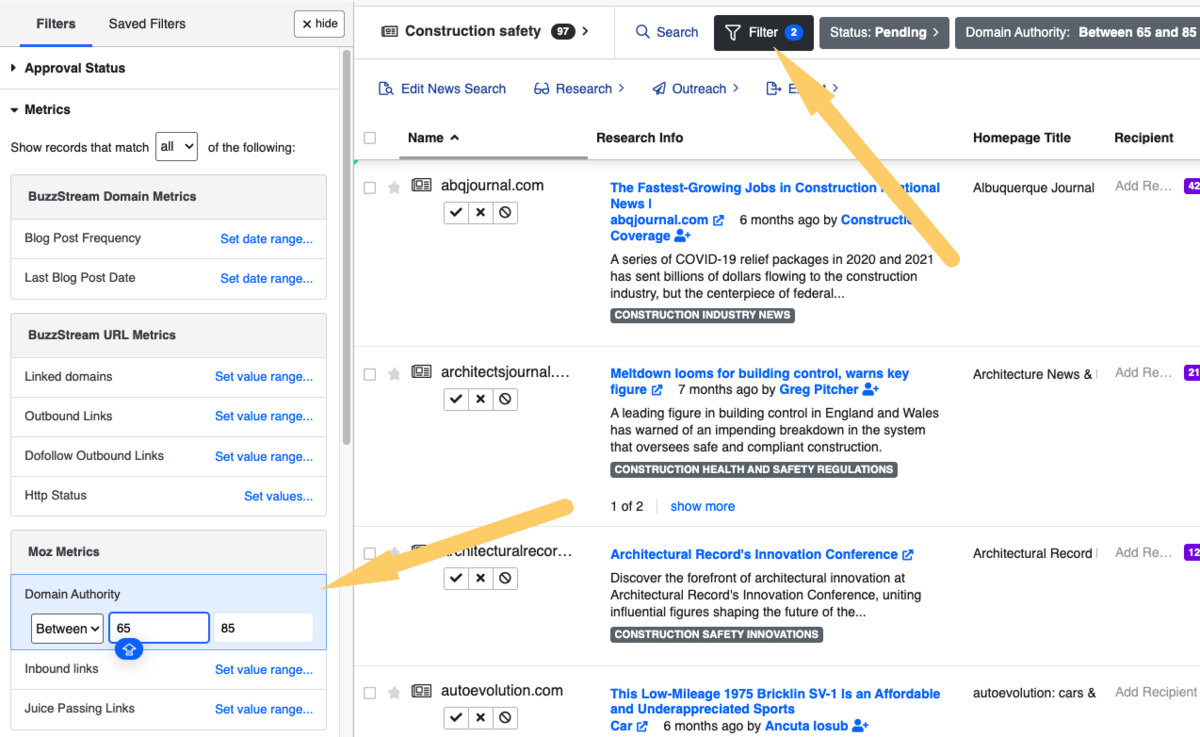
2. Find Niche Publications
Most campaigns have sub-angles or specific niches that you can lean into to get more coverage.
For example, if your post is about the Best Cities for Restaurants, you could pitch news sites in all of the cities listed, but you can also pitch niche sites that talk about restaurants and food.
Taking that one step further, you can find publications about city-specific restaurants and food.
The process takes understanding your core audience and then any ancillary angles.
It really comes down to asking yourself, “Who else might find this interesting?” We can do this analysis virtually for any content-led digital PR campaign.
If we do this for our Best Cities for Restaurants post, a simple Google search for the New York + food will yield niche sites like Eater New York or Grub Street.
These are sites that most likely won’t be talking about the election.
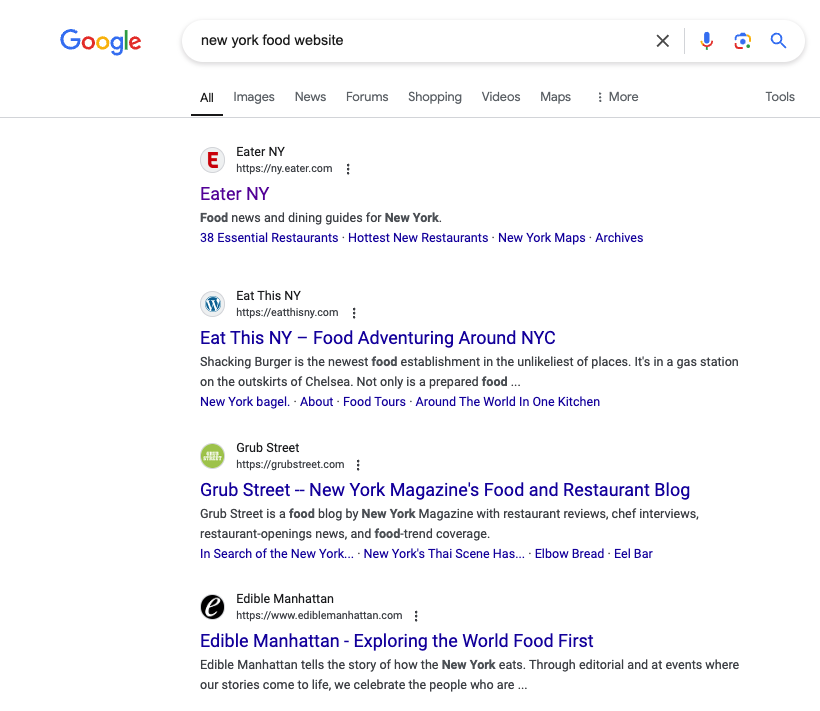
Let’s look at another real-life example.
Say we were trying to pitch this study about lying on your resume to get a job like StandoutCV did.
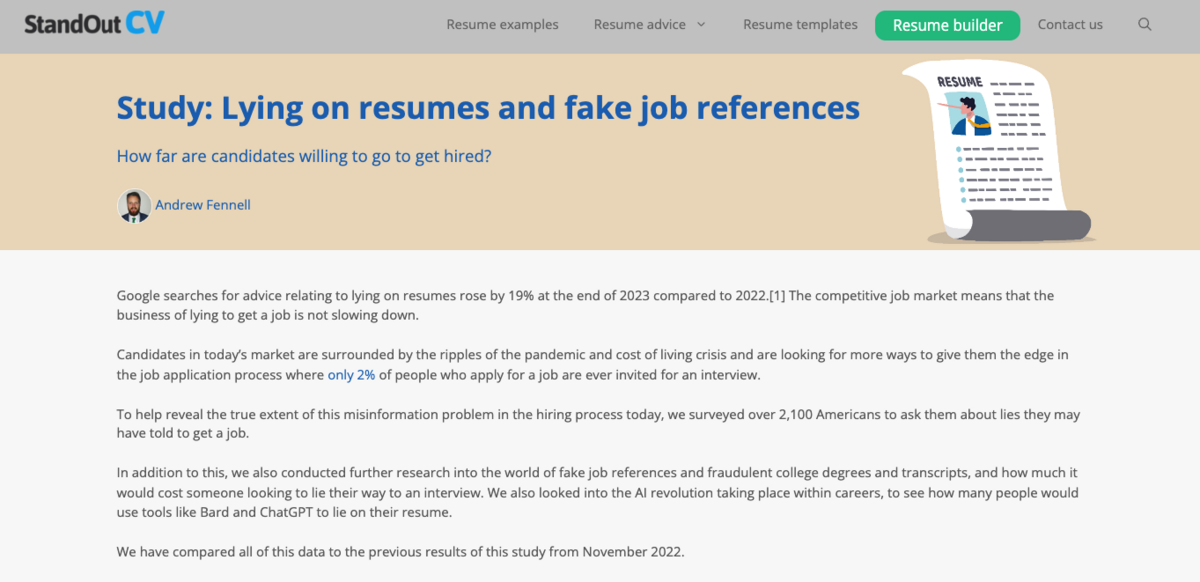
The primary angles and targets here would be business sites.
But when we ask who else might be interested, we find that the post features data about specific industries:

The top industries where people lie on their resumes, such as arts and creative, qualify as “niche” sites, as do sites where people rarely lie, like the sites that cover the business of healthcare.
Arts and retail news sites will most likely not be bogged down with election coverage.
As we mentioned, the tactic relies somewhat on content-led digital PR. But perhaps you don’t have enough time or cannot find a fit.
The next tip is to completely switch away from digital PR.
Tactic 4: Switch Strategies to Produce Evergreen Content
“We’ll shift to evergreen content like organic link generators and use the slower holiday period to conduct in-depth research for trends reports and data studies we plan to publish in January.”
The above is from Emily Campbell Snidal, VP of Marketing at Siege Media. She explained, “This blended strategy will help us continue to build momentum as we navigate a noisy news cycle.”
I used to work with Siege Media, so this approach is unsurprising. Siege Media was great at strategically using SEO and digital PR to achieve link goals even during a crowded news cycle.
For our purposes, there are two kinds of evergreen keywords: standard evergreen keywords and keywords with high link intent. While there is some crossover between the two, they serve unique purposes.
Here’s how to do it.
1. Evergreen Informational Keywords
As you may know, evergreen keywords can produce top-to-mid-funnel organic traffic to your site.
Typical evergreen keywords do not require much updating quarterly or yearly and maintain consistent interest over time. Examples include “how to save money” or “best workout routine.”
This post is an evergreen topic because elections occur yearly worldwide. There are local elections, national elections, etc. This piece doesn’t have to be updated too much to be still relevant for users even if they were to find it next year.
Here’s a quick and straightforward way to find them using a few newer Ahrefs features.
Use the keyword tool Ahrefs Keywords Explorer and enter your core keywords.
Let’s use the cybersecurity industry and choose a keyword like “malware.”
Then, let’s group by parent topic.
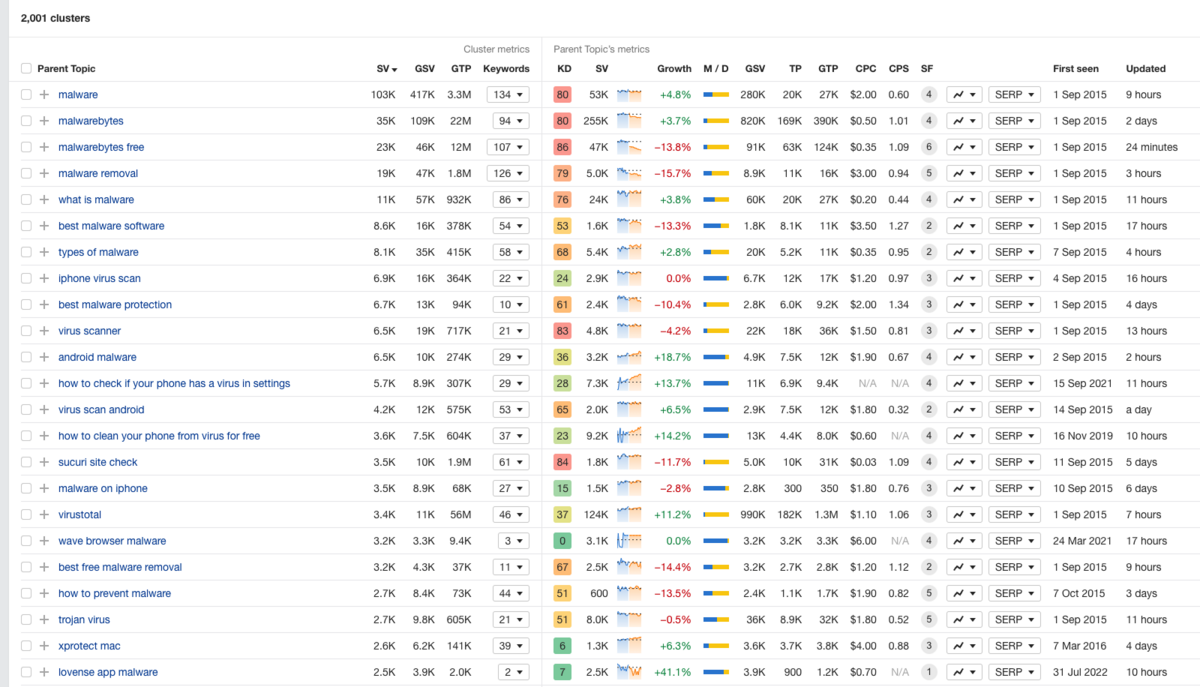
Next, let’s filter down to keywords that have grown in the past three months and have a lower difficulty:

Now, we have a list of potential topics growing in interest with lower keyword difficulty.
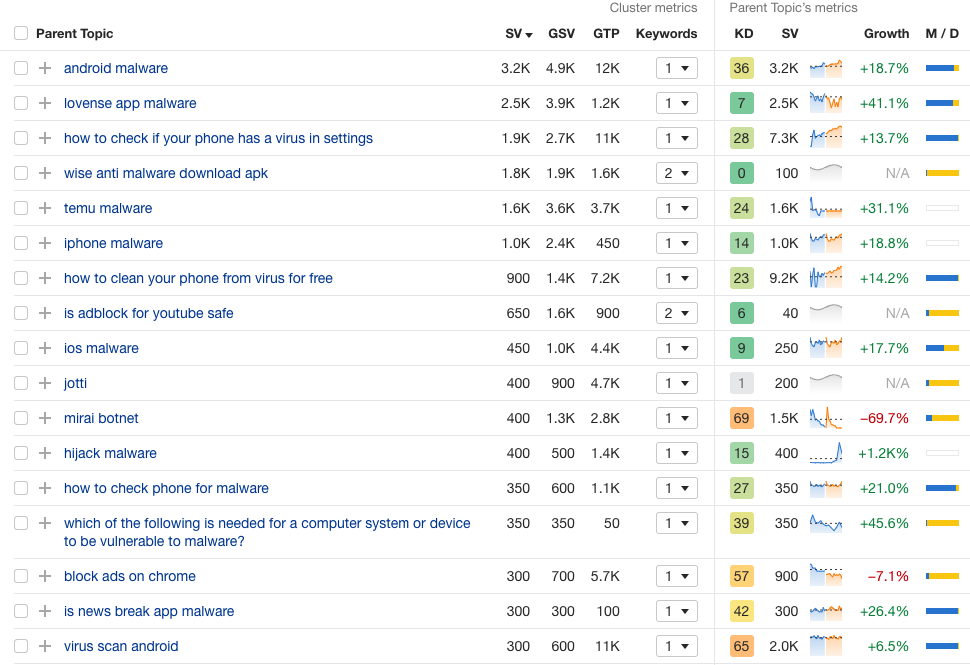
Now, we can click on the keywords and ensure they want informational content written about them.
Scroll down to SERP overview and click “Identify intents.” Ahrefs has a feature that uses AI to infer the kind of content Google is looking for based on the keyword.
As shown below, 39% want guide content, and another 29% are categorized as instructional content. So, it is safe to say that this keyword calls for an instructional guide.

Never rely entirely on keyword tools for content research.
That’s one way to find evergreen keywords. These can help you gain organic traffic and are a good use of time during down periods.
But remember, organic keywords can take 1-3 months to rank. So, this is all about setting you or your client up for success after the election cycle.
Another set of keywords can help contribute to your link goals in the longer term (but not as much in the short term).
2. Keywords With High Link Intent
Evergreen keywords with high link intent can drive traffic and get users to link to your site.
High link intent keywords are the ones that journalists and researchers typically search for when researching content.
The most obvious version of this is a “statistics” or “trends” posts but these can also be tools and calculators.
Here’s how to find keywords in your niche with high link intent:
Use the Ahrefs’ keyword research tool again. Choose a core keyword and add “statistics” or “trends” after it.
Let’s use malware again.

If I sort by Parent Topic again, I see malware statistics and mobile malware statistics.
Let’s click on mobile malware statistics:
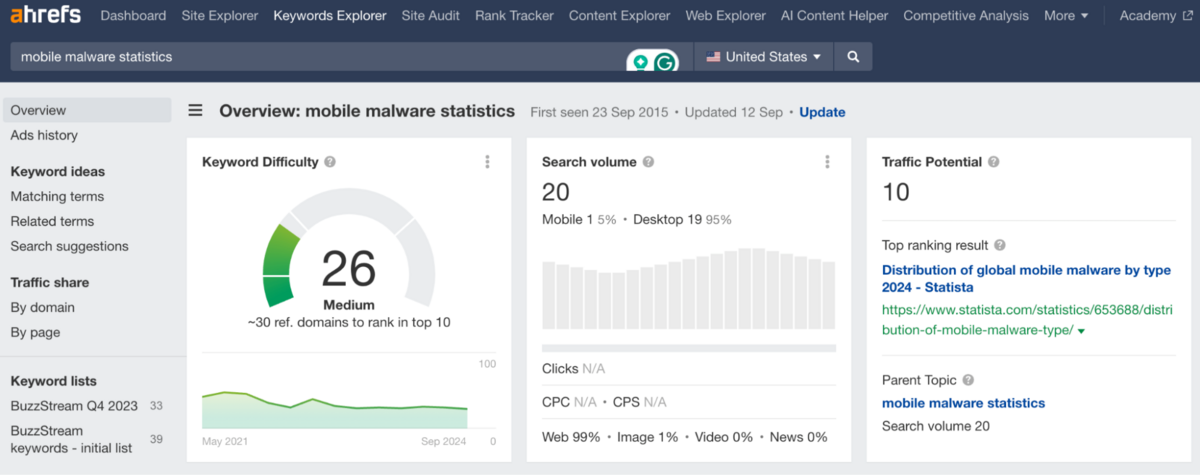
It has a keyword difficulty of 26 and a search volume of 20.
Let’s check out the SERP overview and see if the ranking posts are gaining backlinks and referring domains.
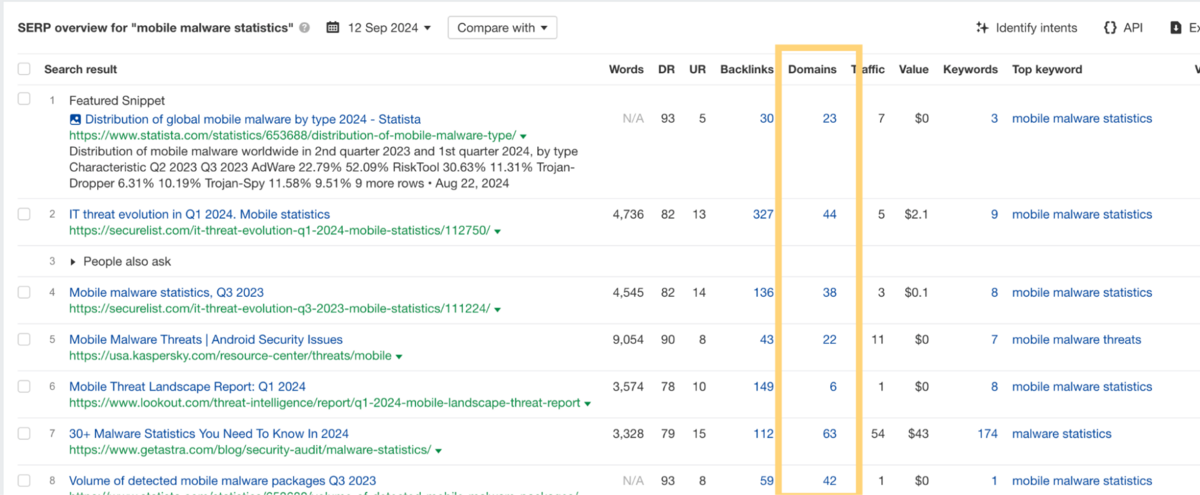
You can see it’s about 30~40 on average.
This is fairly low. Although the keyword difficulty says 23, I see that the DR of the top-ranking posts is all in the 80s and 90s.
So, that’s not worth the investment to me.
We can compare to “malware statistics”:
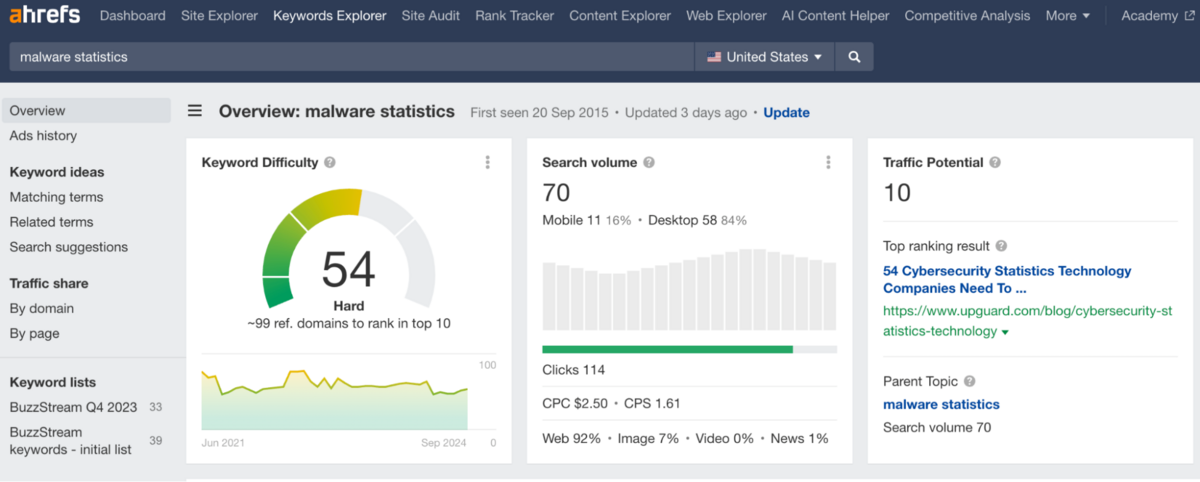
This has a keyword difficulty of 54, but the top ranking posts get many more links.
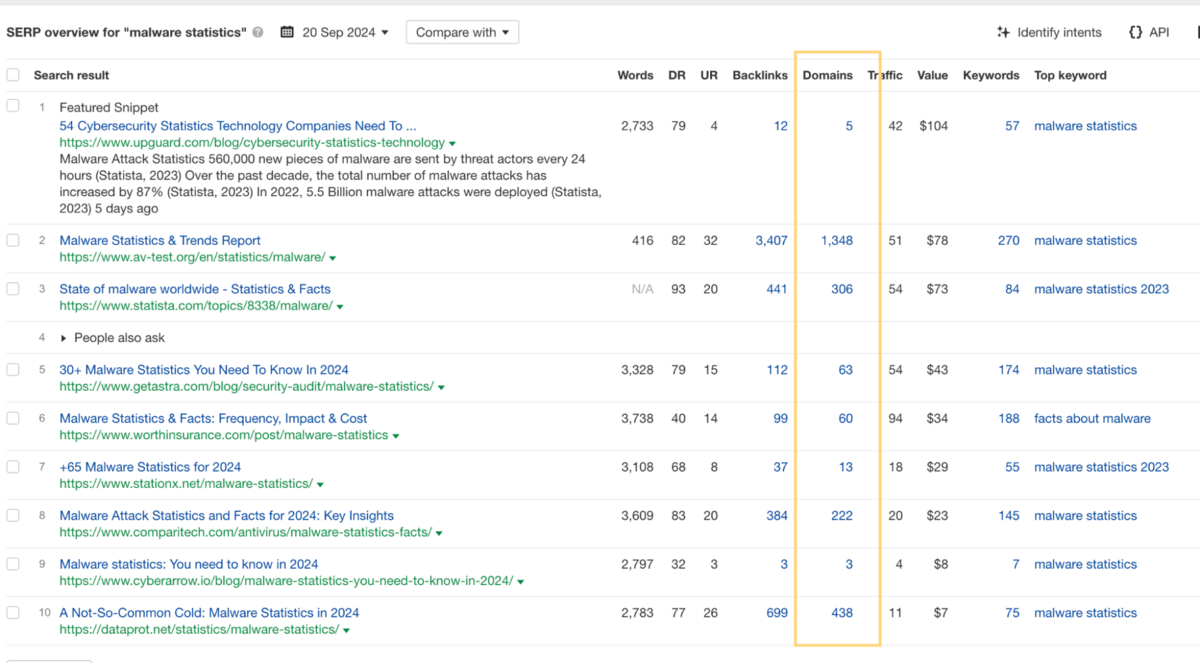
Although this is a much more competitive SERP, it may be wise to choose something like this because it should net a higher number of links.
In the case of high link intent keywords, it typically takes about 6-8 months to really see the fruits of your labor, but once you get them ranking, they create a flywheel where more links help rank better, which get you more links, and so on.
If you need more information on this technique, I recommend checking this section on our link building tactics post.
This leads me to my last tactic for digital PR during an election: switch to more traditional, white hat link building methods that are more supplemental rather than full strategies.
Tactic 5: Supplement With Traditional Link Building Strategies
As I wrote in our post about digital PR for link building, traditional methods are not as scalable as they once were.
Instead, they should be used opportunistically or to supplement link goals.
Here are the best ones that pair with your digital PR strategies.
1. Unlinked Mentions
For most in the digital PR game, you are used to journalists and publications mentioning your content without linking.
Unlinked mentions look like this:
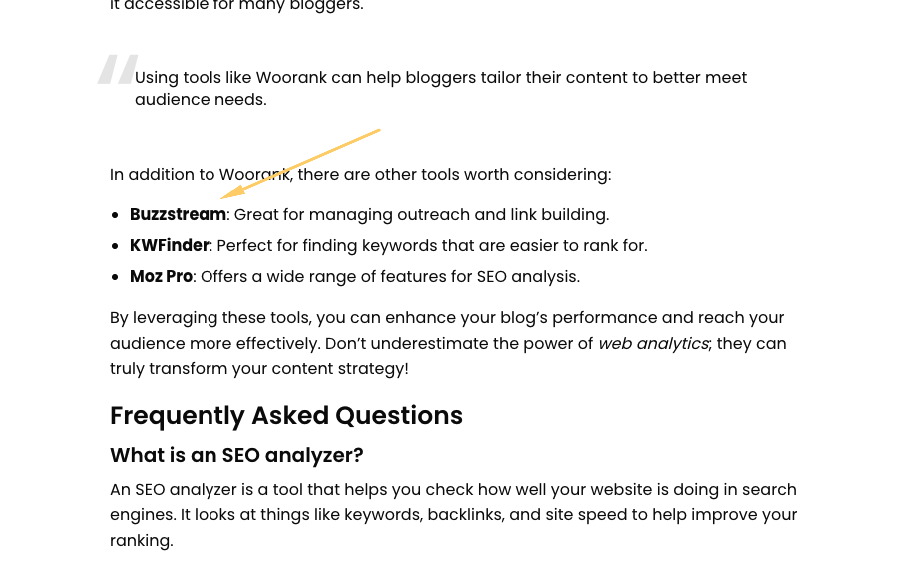
They mentioned BuzzStream but didn’t add a link.
Sometimes this is due to a sitewide policy, other times the journalist might just forget.
Either way, it’s always worth following up and asking the journalist if they’d be able to link to your brand.
We have a whole post on finding and reclaiming unlinked mentions so I won’t get into the full rundown here but this is the shortened version:
Use a tool like Talkwalker to set up brand alerts. Whenever you see one come in, check to see if your brand name has a link.
If not, reach out to the publication asking them to add it with an email that looks something like this:
Hi [First Name],
Thanks so much for mentioning [Your Brand/Site] in your [Research Page Title] post.
Would you be able to add a link to [your post]?
Please let us know what you think!
It’s short and sweet and works most of the time.
2. Pitch to Newsletters and Roundups
This tactic is less known and I’ll be honest isn’t really a traditional link building method but I’ve written about it a bit in our newsletter.
It involves identifying people within your niche or industry who have newsletters and pitching your content directly to them for inclusion in the newsletter.
This is like old-fashioned blogger email outreach and does an excellent job of circumventing the news cycle.
To get links from roundups, you can use terms like:
industry + roundup
industry + weekly roundup
industry + monthly roundup
industry + link roundup
industry + weekly links
industry + monthly links
For instance, there are a lot in the SEO space.
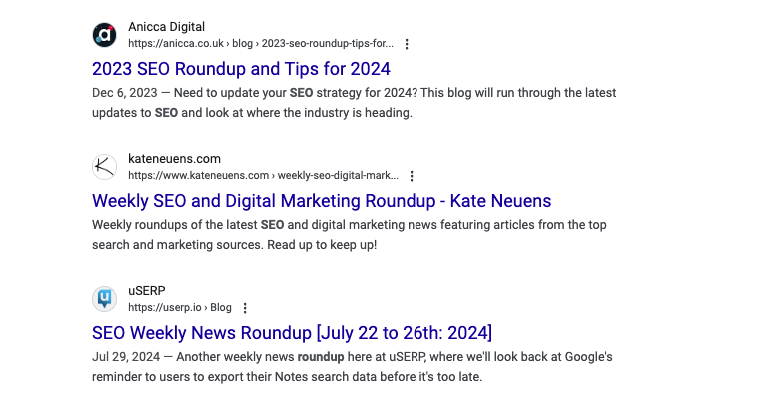
Then, you can use the same tactic that you would to reach out to the authors of these posts to pitch your content for inclusion.
It might look something like this:
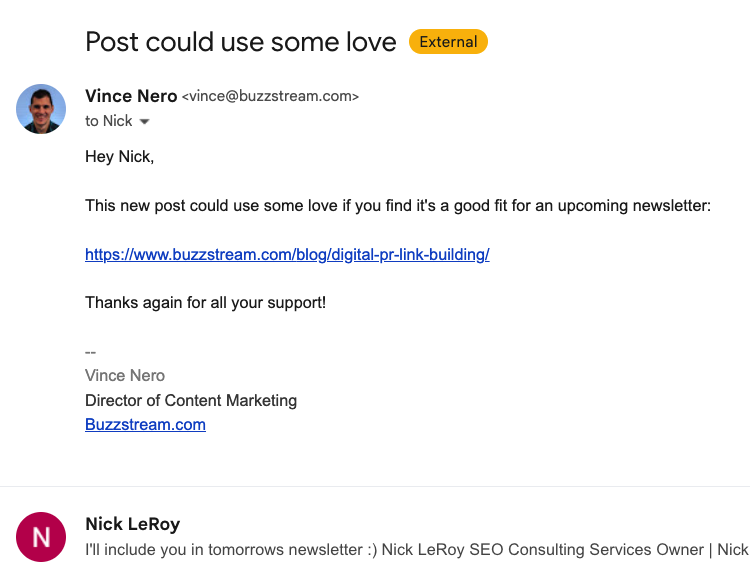
But you can’t do it for every post, and you have to watch the frequency with which you ask for coverage.
After a while, though, you can build relationships so that you don’t have to ask every time because you are already on their radar.
You should also be prepared to offer a favor back.

It’s all about building relationships!
Communication with Clients and Stakeholders is Critical
You’ll notice a theme in most of these insights from experts, and that’s communication.
From Will: “My biggest piece of advice is plan ahead and make sure you’re clients are aware of the challenges we’re about to face”.
No matter who you are or where you work, things will happen that prevent you from achieving results.
The more you communicate with your managers, clients, and whoever else is above you, the less of an impact everyone will feel.
There’s nothing like being blindsided, so that’s what you want to avoid.
I recommend communicating at least a month early if not sooner. You can use a message like the below:
Hi NAME,
As you know, the election is coming up, which we anticipate will impact our link goals and conversion goals. We expect them to drop by X percent.
Therefore, for the duration of the election time period of DATE to DATE we’ve decided to shift to STRATEGY A.
We expect this to help improve Y.
At DATE we’ll shift back to our original strategy to keep things moving towards our goals.
Thanks, I’m happy to hop on a call to discuss any questions or concerns you may have.
Have questions about how to get your brand to stand out during a busy season?
Email me or connect with me on LinkedIn, I’m happy to help.
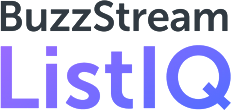
 End-to-end outreach workflow
End-to-end outreach workflow



 Check out the BuzzStream Podcast
Check out the BuzzStream Podcast







